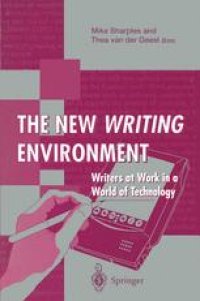
Ebook: The New Writing Environment: Writers at Work in a World of Technology
- Tags: Applied Linguistics, Software Engineering/Programming and Operating Systems, Popular Computer Science, Programming Techniques
- Year: 1996
- Publisher: Springer-Verlag London
- Edition: 1
- Language: English
- pdf
Information technology is changing the way we write. Special features such as outliners, spelling checkers and graphic facilities have transformed word processors into document processors; document processors have, in turn, integrated with other electronic resources such as e-mail and the Internet to provide a complete writing environment. The NewWriting Environment examines the knowledge that is needed in order to develop, use and evaluate computer-based writing environments. The emphasis is firmly on practical issues: tasks performed by writers at work, problems they encounter, and documents they actually produce. Writing is defined within a wide social and organisational context, in order to give an accurate assessment of how the new technology affects the social and cooperative aspects of authorship. The result is a wide-ranging and comprehensive assessment of the relationship between writing and computers.
Information technology is changing the way we write. Special features such as outliners, spelling checkers and graphic facilities have transformed word processors into document processors; document processors have, in turn, integrated with other electronic resources such as e-mail and the Internet to provide a complete writing environment. The NewWriting Environment examines the knowledge that is needed in order to develop, use and evaluate computer-based writing environments. The emphasis is firmly on practical issues: tasks performed by writers at work, problems they encounter, and documents they actually produce. Writing is defined within a wide social and organisational context, in order to give an accurate assessment of how the new technology affects the social and cooperative aspects of authorship. The result is a wide-ranging and comprehensive assessment of the relationship between writing and computers.
Information technology is changing the way we write. Special features such as outliners, spelling checkers and graphic facilities have transformed word processors into document processors; document processors have, in turn, integrated with other electronic resources such as e-mail and the Internet to provide a complete writing environment. The NewWriting Environment examines the knowledge that is needed in order to develop, use and evaluate computer-based writing environments. The emphasis is firmly on practical issues: tasks performed by writers at work, problems they encounter, and documents they actually produce. Writing is defined within a wide social and organisational context, in order to give an accurate assessment of how the new technology affects the social and cooperative aspects of authorship. The result is a wide-ranging and comprehensive assessment of the relationship between writing and computers.
Content:
Front Matter....Pages i-x
Front Matter....Pages 1-1
Introduction....Pages 5-6
Professional Writing Studied: Authors’ Accounts of Planning in Document Production Processes....Pages 7-24
Writing, Speaking, Drawing: the Distribution of Meaning in Architects’ Communication....Pages 25-42
Adjusting Target Figures Downwards: On the Collaborative Writing of Policy Documents in the Dutch Government....Pages 43-52
Front Matter....Pages 53-56
Introduction....Pages 57-58
Computer Support for Producing Software Documentation: Some Possible Futures....Pages 59-72
Academic Writing and Information Retrieval....Pages 73-86
Professional Authorship in the Electronic World....Pages 87-95
Designs for New Writing Environments....Pages 97-115
Front Matter....Pages 117-120
Introduction....Pages 121-122
Two Investigations into Intelligent Text Processing....Pages 123-145
Detecting Stylistic Inconsistencies in Collaborative Writing....Pages 147-168
User-oriented Index Design for Computer-based Documentation....Pages 169-176
Front Matter....Pages 177-180
Introduction....Pages 181-182
Spider Webs, Symphonies and the Yellow-Brick Road: Form and Structure in Electronic Texts....Pages 183-206
Knowledge Package Construction and Conceptual Navigation using a System for Universal Media Searching (SUMS)....Pages 207-215
When Worlds Collide: Merging Face-to-face and Virtual Academic Conferences....Pages 217-236
Citizens’ Networks: Examples of Utopian Uses of Computer-mediated Communication....Pages 237-256
Back Matter....Pages 257-274
Information technology is changing the way we write. Special features such as outliners, spelling checkers and graphic facilities have transformed word processors into document processors; document processors have, in turn, integrated with other electronic resources such as e-mail and the Internet to provide a complete writing environment. The NewWriting Environment examines the knowledge that is needed in order to develop, use and evaluate computer-based writing environments. The emphasis is firmly on practical issues: tasks performed by writers at work, problems they encounter, and documents they actually produce. Writing is defined within a wide social and organisational context, in order to give an accurate assessment of how the new technology affects the social and cooperative aspects of authorship. The result is a wide-ranging and comprehensive assessment of the relationship between writing and computers.
Content:
Front Matter....Pages i-x
Front Matter....Pages 1-1
Introduction....Pages 5-6
Professional Writing Studied: Authors’ Accounts of Planning in Document Production Processes....Pages 7-24
Writing, Speaking, Drawing: the Distribution of Meaning in Architects’ Communication....Pages 25-42
Adjusting Target Figures Downwards: On the Collaborative Writing of Policy Documents in the Dutch Government....Pages 43-52
Front Matter....Pages 53-56
Introduction....Pages 57-58
Computer Support for Producing Software Documentation: Some Possible Futures....Pages 59-72
Academic Writing and Information Retrieval....Pages 73-86
Professional Authorship in the Electronic World....Pages 87-95
Designs for New Writing Environments....Pages 97-115
Front Matter....Pages 117-120
Introduction....Pages 121-122
Two Investigations into Intelligent Text Processing....Pages 123-145
Detecting Stylistic Inconsistencies in Collaborative Writing....Pages 147-168
User-oriented Index Design for Computer-based Documentation....Pages 169-176
Front Matter....Pages 177-180
Introduction....Pages 181-182
Spider Webs, Symphonies and the Yellow-Brick Road: Form and Structure in Electronic Texts....Pages 183-206
Knowledge Package Construction and Conceptual Navigation using a System for Universal Media Searching (SUMS)....Pages 207-215
When Worlds Collide: Merging Face-to-face and Virtual Academic Conferences....Pages 217-236
Citizens’ Networks: Examples of Utopian Uses of Computer-mediated Communication....Pages 237-256
Back Matter....Pages 257-274
....